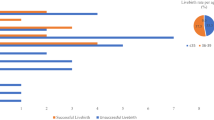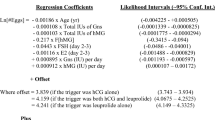Abstract
Purpose
In women the relationship between myotonic dystrophy type I and fertility remains controversial. The objective of this study was to evaluate the ovarian reserve, ovarian response to stimulation and oocyte quality in these patients.
Materials and methods
We compared 15 myotonic dystrophy type I patients with 39 age matched controls with isolated male factor infertility necessitating ICSI.
Results
All parameters of ovarian reserve (day 3 FSH and E2, antral follicle count and delta E2) were significantly better in the controls. Despite having significantly lower doses of gonadotrophin, the control group attained a higher number of retrieved oocyte–cumulus complexes (p < 0.04). Analysis of cytoplasmic and extracytoplasmic dysmorphism did not reveal any difference between the two groups. Fertilisation rate and top grade embryos on day 3 were similar in both groups.
Conclusion
The present study suggests that though women with myotonic dystrophy type I have a reduced ovarian reserve and respond poorly to controlled ovarian stimulation, there is no impact on oocyte and embryo quality. Hence suggesting that successful ART is feasible with appropriate selection in women with mild myotonic dystrophy.
Similar content being viewed by others
References
Magee AC, Hughes AE, Kidd A, Lopez de Munain A, Cobo AM, Kelly K, Dean J, Nevin NC. Reproductive counseling for women with myotonic dystrophy. J Med Genet 2002;39:15–7.
Roses AD, Apple SH. Protein kinase activity in erythrocyte ghosts in patients with myotonic muscular dystrophy. Proc Natl Acad Sci USA 1973;70:1855–9.
Buxton J, Shelbourne P, Davis J. Detection of an unstable fragment on DNA specific to individuals with myotonic dystrophy. Nature 1992;335:547–8.
Harley HG, Brooke JD, Rundle SA. Detection of an unstable DNA region and phenotypic variation in myotonic dystrophy. Nature 1992;355:545–6.
Harper PS. Myotonic dystrophy. 3rd edn. London: Saunders; 2001. p. 237.
Vazquez JA, Pinies JA, Martul P. Hypothalamic–pituitary–testicular function in 70 patients with myotonic dystrophy. J Endocrinol Invest 2001;13:375–9.
Hortas ML, Castilla JA, Gil MT. Decreased sperm function of patients with myotonic muscular dystrophy. Hum Reprod 2000;15:445–8.
Dao TN, Mathieu J, Bouchard JP, De Braekeleer M. Fertility in myotonic dystrophy in Saguenay-Lac-St-Jean: a historical perspective. Clin Genet 1992;42:234–9.
Ulloa-Aguirre A, Larrea F, Shkurovich M. Hypothalamic hypogonadism in myotonic dystrophy. Obstet Gynecol 1981;57:67S–9S.
Feyereisen E, Amar A, Kerbrat V, et al. Myotonic dystrophy: does it affect ovarian follicular status and responsiveness to controlled ovarian stimulation? Hum Reprod 2006;21:175–82.
Muttukrishna S, McGarrigle H, Wakim R, Khadum I, Ranieri DM, Serhal P. Antral follicle count, anti-mullerian hormone and inhibin B: predictors of ovarian response in assisted reproductive technology? BJOG 2005;112:1384–90.
Ebner T, Moser M, Sommergruber M, Tews G. Selection based on morphological assessment of oocytes and embryos at different stages of preimplantation development. Hum Reprod Update 2003;9:251–62.
Van Steirteghem AC, Nagy Z, Joris H. High fertilization and implantation rate after ICSI. Hum Reprod 1993;8:1061–6.
Desai NN, Goldstein J, Rowland DY, Goldfarb JM. Morphological evaluation of human embryos and derivation of an embryo quality scoring system specific for day 3 embryos: a preliminary study. Hum Reprod 2000;15:2190–6.
De Sutter P, Dozortsev D, Qian C, et al. Oocyte morphology does not correlate with fertilization rate and embryo quality after intracytoplasmic sperm injection. Hum Reprod 1996;11:595–7.
Ebner T. Is oocyte morphology prognostic of embryo developmental potential after ICSI? Reprod BioMed Online 2006;12:507–12.
Otsuki J, Okada A, Morimoto K, Nagai Y, Kubo H. The relationship between pregnancy outcome and smooth endoplasmic reticulum clusters in MII human oocytes. Hum Reprod 2004;19:1591–7.
Ebner T, Yaman C, Moser M, et al. Prognostic value of first polar body morphology on fertilization rate and embryo quality in intracytoplasmic sperm injection. Hum Reprod 2000;15:427–30.
Marchini C, Lonigro R, Verriello L, Pellizzari L, Bergonzi P, Damante G. Correlations between individual clinical manifestations and CTG repeat amplification in myotonic dystrophy. Clin Genet 2000;57:74–82.
Author information
Authors and Affiliations
Corresponding author
Additional information
Capsule Women with myotonic dystrophy type I have reduced ovarian reserve and respond poorly to controlled ovarian stimulation, though there is no impact on oocyte quality.
Rights and permissions
About this article
Cite this article
Sahu, B., Ozturk, O., Deo, N. et al. Response to controlled ovarian stimulation and oocyte quality in women with myotonic dystrophy type I. J Assist Reprod Genet 25, 1–5 (2008). https://doi.org/10.1007/s10815-007-9193-y
Received:
Accepted:
Published:
Issue Date:
DOI: https://doi.org/10.1007/s10815-007-9193-y




